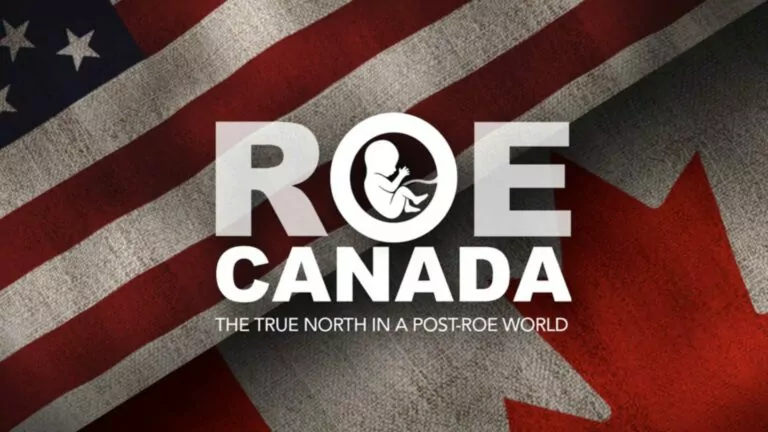Not without a fight: the history of the pro-life movement in Canada
Pro-life activists perform an important role in society. They help to remind people about what is perhaps the most pressing political issue in our country, namely, the legally-sanctioned killing of unborn children. This killing is often justified as being the consequence of a "woman's right to chose." In Canada, exterminating the unborn is considered to be a "human right" supported by all levels of government and all of the major political parties. But this phrase, "a woman's right to choose," is simply a euphemism for the killing of unborn babies. It's a clever choice of words to hide the reality of abortion.
Of course, abortion is a worldwide phenomenon, not a specifically Canadian one. All of the Western countries allow abortion, although Canada is unique among them in having no legal restrictions on abortion whatsoever. But it is helpful to see the abortion controversy in its international context. The Canadian pro-life movement has not been successful in stopping abortion in Canada, but the same is true of pro-life movements in the USA, Australia, and elsewhere.
It's not that Canada's pro-lifers have failed to find the right tactic - some silver bullet that would put an end to the killing. Rather, the Canadian situation reflects a worldwide embrace of abortion by cultures that want to separate sexual activity from its consequences. A history of the abortion fight in Canada demonstrates that the Canadian pro-life movement has been very adept, thoughtful, strategic and thorough in their various attempts to stop abortion. But despite the movement’s best efforts, it was not able to stem the tide.
It began in 1969
In Canada, the push to legalize abortion came on strong during the 1960s. Towards the end of that decade, Parliament was looking into the matter, and in 1969 the Liberal government of Pierre Trudeau passed a bill easing the Criminal Code restrictions on abortion.
Although the new law did not completely decriminalize abortion, it made abortion more easily available. Hospitals could each have a therapeutic abortion committee (TAC), and the committee could approve an abortion after three doctors confirmed that a pregnancy would likely endanger the life or health of a particular woman. Women seeking abortions were normally approved for the procedure.
The pro-life movement in Canada emerged in response to the 1969 law. By the mid-1970s there were dozens of pro-life groups across Canada. The main national organization was the Alliance for Life headed by Dr. Heather Morris. In 1973 the pro-life groups gathered a petition of 352,000 signatures requesting a stricter abortion law. This petition was presented to Prime Minister Trudeau. Then in 1975, the Petition of One Million campaign managed to get over a million signatures on a petition opposing abortion. Yet, despite this tremendous effort, it was not successful in leading to any legislative change.
Two key figures
In 1978 a new pro-life group called Campaign Life was formed. It represented the more conservative and militant segment of the pro-life movement and continues today as the leading pro-life organization in the country. In the national debate about adopting a Charter of Rights in 1981, Campaign Life's legal counsel, Gwen Landolt, accurately predicted the negative consequences that would result from the Charter.
Another major pro-life figure was Joe Borowski, a former Manitoba cabinet minister in that province's NDP government of the early 1970s. In 1978 Borowski launched a court challenge to Canada's abortion law, arguing that it violated the Canadian Bill of Rights which guaranteed the right to life.
There was considerable legal wrangling over whether Borowski even had the right to launch such a challenge, and it wasn't until 1983 that his case was finally heard. By this time the Charter of Rights had been adopted, so his challenge was modified to argue that the abortion law violated the Charter's guarantee of the right to life. Borowski lost later in 1983, but he continued to press his case and the Supreme Court of Canada agreed to hear it in 1988.
Morgentaler starts fighting
In the meantime, another significant case was winding its way through Canada's courts. From the early 1970s on, Henry Morgentaler, the leading abortionist in Canada, was in and out of the courts for violating the terms of Canada's abortion law. Morgentaler opposed the abortion law because he thought it was too restrictive. The law only allowed abortions to be performed in hospitals, whereas Morgentaler wanted to be able to perform them in abortion clinics. He was ultimately successful in operating a clinic in Quebec where public sentiment strongly supported abortion rights.
When Morgentaler opened a clinic in Toronto in 1983 (the first abortion clinic in English Canada), he was charged with performing illegal abortions. He fought this charge all the way to the Supreme Court of Canada which heard his case in October 1986.
Pro-lifers were very active during this period. In some locations across Canada, pro-lifers were able to get elected to local hospital boards and shut down that hospital’s TAC. Thus the hospital would no longer be able to perform abortions. This was an especially effective tactic in the Maritime provinces.
There were also numerous protests and demonstrations in front of Morgentaler's Toronto abortuary. Occasionally some pro-life activists would attempt to block the steps leading to the "clinic" and would be arrested. An organization called Choose Life Canada was formed by Baptist minister Ken Campbell, and it managed to set up its office right next to the Morgentaler facility. This office was called The Way Inn and it was in a perfect location to dissuade women from proceeding with their abortions.
January 28, 1988
Then, on January 28, 1988, the infamous Morgentaler decision was handed down by the Supreme Court, striking down Canada's abortion law and consequently eliminating all legal restrictions on abortion in the country. However, this decision did not create a "right" to abortion in Canada. Instead, the law had been struck down for violating the procedural fairness required by the Charter. Thus the way was left open for Parliament to enact a new law restricting abortion.
Pro-life organizations could likely have intervened in the Morgentaler case but had chosen not to. They were active in supporting Borowski's case and did not think they had the resources to also be involved in Morgentaler's. At the time, Gwen Landolt argued that this was a mistake. As usual, she was right.
The mistake became clear to all when the Supreme Court heard Borowski's case in October 1988, months after the Morgentaler decision. Borowski was challenging the very abortion law which had previously been thrown out in the Morgentaler decision. So, since the law had already been thrown out, in March 1989 the Supreme Court ruled that the case was moot. The pro-lifers lost again.
In the wake of the Morgentaler decision, pro-life groups organized a massive letter-writing campaign urging members of Parliament (MPs) to pass a restrictive abortion law. But there were deep divisions even within the governing Progressive Conservative caucus of Prime Minister Brian Mulroney, so despite some attempts, nothing was accomplished.
The infamy of 1988 – when free trade trumped life
A federal election was called for the fall of 1988, and pro-life groups were very active in trying to elect pro-life MPs. However, the central issue in this election campaign was the proposed Free Trade Agreement with the USA, so the abortion issue did not really receive a lot of attention. Nevertheless, some new pro-life MPs were elected.
Many pro-lifers were becoming increasingly frustrated by the lack of any legal restrictions on abortion in Canada and therefore became involved in an American-based organization called Operation Rescue led by a theologically charismatic minister, Randall Terry. The "rescuers," often in large numbers, would use their bodies to block the entrances to abortuaries so that women could not enter them. It was hoped that this would prevent abortions from being performed. The police, of course, would move in and arrest the rescuers. Most of this rescue activity took place in the first half of 1989.
When is moot not moot?
By the summer of 1989 the courts were back in the center of the abortion fight. In July an Ontario court and a Quebec court each issued an injunction preventing a woman from having an abortion, both at the instigation of former boyfriends. The Ontario injunction against Barbara Dodd, however, was quickly overturned by the Ontario Supreme Court so she went to the Morgentaler clinic for an abortion.
But in the other case, the Quebec Superior Court upheld the injunction against Chantal Daigle, and two weeks later the Quebec Court of Appeal also upheld the injunction. This latter decision went so far as to declare that unborn children had a right to life! Can you imagine?! Anyway, Canada was now in the midst of a full-fledged national crisis. The achievements of the pro-abortion camp were severely threatened by the Quebec Court of Appeal decision. An emergency session of the Supreme Court of Canada was called, and organizations from both sides of the abortion debate were granted intervener status, including Campaign Life and REAL Women of Canada.
During the court proceedings, Daigle's lawyer announced that she had gone to the US and had an abortion there, making the case moot. Despite being moot, the Supreme Court proceeded to strike down the injunction against Daigle. This makes for a very interesting contrast. When Joe Borowski's case became moot, the Supreme Court refused to deal with it for that reason. But when Chantal Daigle's case became moot, the Supreme Court decided the issue anyway. It appears that the Supreme Court is willing to proceed with a moot case, but only as long as doing so will further the pro-abortion cause. This is "justice" in Canada.
A law both sides hated
In November 1989 the Mulroney government introduced Bill C-43, a new proposed abortion law. It made abortion a criminal offence, except where the pregnant woman desired to have one for reasons of physical, mental, or psychological health. Although the pro-abortion camp opposed the bill because it technically criminalized abortion, many conservative Christians saw the loopholes in it as basically enshrining abortion on demand. People such as Ken Campbell, Ted Byfield of Alberta Report, and Gwen Landolt of REAL Women opposed the bill on these grounds. Some other pro-life organizations, such as the Evangelical Fellowship of Canada, supported the bill for pragmatic reasons, arguing that it was better to have a faulty law with some restrictions on abortion than no law whatsoever.
Despite strong opposition from both the pro and anti-abortion camps, the bill passed the House of Commons in May 1990. However, it still had to pass the Senate, so opponents had another chance to block it. The Senate vote in January 1991 was a tie, and ties count as a loss by Senate rules. Thus the abortion bill failed and Canada remained without any legal restrictions on abortion. This is still the situation today.
We have work to do
The pro-life movement has remained active since that time, but no Canadian government has even attempted to bring in an abortion law since the failure of Bill C-43.
The pro-life movement in Canada has lost all of its major battles. In this respect, it looks like a failure. But viewing it that way would be a mistake. As mentioned earlier, the abortion fight is a worldwide phenomenon and even the USA, with strong conservative Christian and pro-life movements, basically has a situation of abortion on demand. If the American movement, with its prominent and powerful Christian activist groups, and sympathetic politicians (including President Bush and most Republican congressmen), can't hold back the pro-abortion tide, can we really expect the Canadian pro-life movement to do any better?
The fact is that Canada's pro-lifers have fought valiantly, using the best means at their disposal. Getting over one million signatures on a pro-life petition in the mid-1970s is quite an achievement. (Remember, they had to do this the old-fashioned way – they did not have the Internet.) But the petition was ignored. Working for the election of pro-life MPs is a reasonable strategy. But every government caucus has contained some pro-life MPs, and yet look at the situation we are in today.
The pro-life movement has tried to use the courts to protect the unborn, with Joe Borowski being the best example of this. But with a judiciary dominated by abortion supporters, this didn't work either. And as a last resort, courageous pro-lifers joined Operation Rescue to use their own bodies to block entrances to abortuaries. And what did they get? Fines and jail time. So it hasn't been for a lack of trying.
The pro-life cause will ultimately prevail and abortion will be outlawed in Canada once again. But it will be a long road, and it will be easy to become discouraged in the meantime. The struggle against abortion needs to be seen in its worldwide context so that the setbacks on this issue in Canada are seen as part of a pattern of setbacks for the pro-life movement around the world. It may be an embarrassment that Canada has no legal restrictions on abortion, but many other Western nations also have high abortion rates so they aren't much different from Canada, really. Their pro-life movements have also "failed" in this respect.
It's not like the pro-life movement is simply missing a winning strategy, and once that strategy is discovered the pro-life side will finally prevail in Canada. The situation is much worse than that. The culture of the Western nations, at least among the controlling elites, is a basically pro-abortion culture, and there will need to be a change at the cultural level before the law is changed. Canada and the other Western countries need to be re-Christianized. Failing that, it's likely that abortion will continue unabated.
Michael Wagner is the author of “Leaving God Behind: The Charter of Rights and Canada’s Official Rejection of Christianity,” available at Merchantship.ca. This article first appeared in the January 2008 issue....












